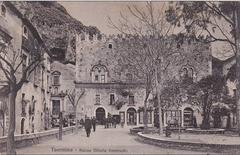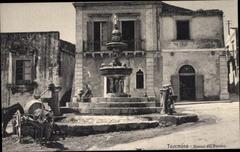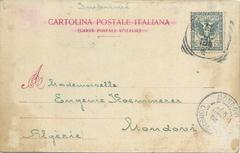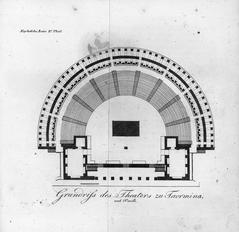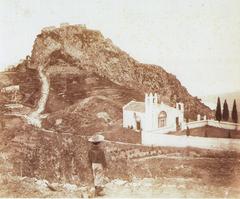
Comprehensive Guide to Visiting Taormina, Metropolitan City of Messina, Italy
Date: 13/08/2024
Captivating Introduction
Welcome to Taormina, a mesmerizing Sicilian town perched elegantly on a cliff overlooking the Ionian Sea. Imagine a place where echoes of ancient civilizations reverberate through cobblestone streets, and every sunset seems to be painted by the gods themselves. From the grandeur of Greek and Roman architecture to the enchanting blend of Norman and Arab influences, Taormina is a living museum that has captivated poets, explorers, and dreamers for centuries. Picture yourself strolling through ancient ruins with the scent of citrus blossoms in the air—this is Taormina, Italy’s best-kept secret, ready to be discovered by you.
Taormina’s history is a tapestry of diverse cultures and eras. Originally inhabited by the Siculi tribe, it was later founded by the Greeks in the 4th century BCE and named Tauromenion. Its strategic location and natural beauty quickly made it a significant settlement (Cultural Italy). The Romans expanded the city’s infrastructure and its iconic Greek theater, which still stands today as a testament to its historical significance. Following the Romans, the Byzantines fortified the city, recognizing its strategic importance (Go Ask a Local). The city underwent further transformations under Arab and Norman rule, each leaving their indelible mark on its culture and architecture (Military Sphere).
Fast forward to the modern era, and Taormina has evolved into a major tourist destination. Its blend of historical sites, cultural events, and natural beauty continues to draw visitors from around the world. Whether you’re attending a performance at the ancient Greek theater, exploring the medieval Palazzo Corvaja, or simply enjoying a leisurely walk through the picturesque streets, Taormina offers a unique blend of ancient heritage and modern charm (World by Weekend). So, pack your bags and get ready to uncover the secrets of Taormina with Audiala, your ultimate tour guide app, and let us take you on an unforgettable journey through this enchanting town.
Table of Contents
Historical Overview of Taormina
Captivating Introduction
Welcome to Taormina, where every cobblestone whispers tales of ancient civilizations and every sunset paints the sky with the hues of history. Perched grandly on a cliff overlooking the Ionian Sea, this Sicilian gem has been a magnet for poets, explorers, and dreamers for centuries. Imagine a place where Greek myths come to life, Roman grandeur still echoes, and Norman knights once roamed. Intrigued? Let’s dive into the captivating history of Taormina!
Ancient Beginnings
Taormina, perched on a promontory overlooking the Ionian Sea, has a history that stretches back to ancient times. The area was originally inhabited by the Siculi, an ancient Sicilian tribe, before the Greeks founded the city in the 4th century BCE. The Greeks named it Tauromenion, and it quickly became an important settlement due to its strategic location and natural beauty. The Greek influence is still evident today, particularly in the ancient Greek theater, which remains one of Taormina’s most iconic landmarks (Cultural Italy).
Roman and Byzantine Eras
Following the Greeks, the Romans took control of Taormina in 212 BCE. Under Roman rule, the city continued to flourish, becoming a significant center for trade and culture. The Romans expanded the Greek theater, adding their architectural touches and increasing its capacity. This period also saw the construction of various public buildings and infrastructure, contributing to Taormina’s prosperity.
After the fall of the Roman Empire, Taormina came under Byzantine control. The Byzantines fortified the city, recognizing its strategic importance. They built walls and other defensive structures, some of which can still be seen today. This era was marked by relative stability and continued cultural development.
Arab and Norman Conquests
In the 9th century, Taormina fell to the Arabs, who brought significant changes to the city’s culture and architecture. The Arabs introduced new agricultural practices, crops, and irrigation systems, which transformed the local economy. They also left their mark on the city’s architecture, with the construction of mosques and other buildings reflecting Islamic design principles.
The Norman conquest in the 11th century marked another significant chapter in Taormina’s history. The Normans, led by Roger I of Sicily, expelled the Arabs and established their rule over the island. They continued to develop the city’s fortifications and built several churches, blending Norman and Arab architectural styles. The Cathedral of Taormina, constructed during this period, is a notable example of this architectural fusion (Go Ask a Local).
Medieval and Renaissance Periods
During the medieval period, Taormina became a vital stronghold in the power struggles between various regional powers. The city’s strategic location made it a coveted prize, leading to numerous conflicts and sieges. One of the most notable events was the Siege of Taormina in the 10th century, which highlighted the city’s importance in regional power dynamics (Military Sphere).
The Renaissance period brought a renewed focus on art and culture to Taormina. The city attracted artists, writers, and intellectuals, who were drawn to its picturesque landscapes and rich history. This era saw the construction of several palaces and public buildings, many of which still stand today, showcasing the architectural styles of the time.
Modern Era and Tourism Boom
In the 18th century, Taormina began to attract European travelers as part of the Grand Tour, a traditional trip through Europe undertaken by young aristocrats to complete their education. The city’s stunning views, ancient ruins, and charming streets made it a popular destination. This trend continued into the 19th and 20th centuries, with Taormina becoming a favorite spot for artists, writers, and celebrities.
The modern era has seen Taormina evolve into a major tourist destination. Its blend of historical sites, cultural events, and natural beauty continues to draw visitors from around the world. The ancient Greek theater, now a venue for concerts and performances, remains a central attraction, offering a unique experience where history and contemporary culture intersect (Cultural Italy).
Key Historical Sites
Greek Theater
The Greek Theater of Taormina, originally built in the 3rd century BCE, is one of the most well-preserved ancient theaters in the world. Its semi-circular design, typical of Greek theaters, ensures excellent acoustics, allowing performances to be heard clearly even in the upper tiers. The theater was later expanded by the Romans, who added their architectural elements. Today, it hosts a variety of cultural events, including concerts, operas, and film festivals, making it a vibrant cultural hub (Cultural Italy).
Palazzo Corvaja
Palazzo Corvaja is a medieval palace that showcases the architectural evolution of Taormina. Originally built in the 10th century by the Arabs, it was later expanded by the Normans and further modified during the Renaissance. The palace now houses the Museum of Popular Arts and Traditions, offering visitors a glimpse into the city’s rich cultural heritage (Go Ask a Local).
Cathedral of Taormina
The Cathedral of Taormina, also known as the Duomo di Taormina, was constructed in the 13th century on the site of an earlier church. The cathedral’s architecture reflects a blend of Norman and Gothic styles, with later Baroque additions. Its interior houses several important artworks, including a 15th-century polyptych by Antonello da Messina. The cathedral remains an active place of worship and a significant historical site (World by Weekend).
Isola Bella
Isola Bella, a small island near Taormina, is another key historical site. The island was a private property until the 20th century when it was purchased by Lady Florence Trevelyan, who created a beautiful garden with exotic plants and Victorian follies. Today, Isola Bella is a nature reserve, offering visitors a chance to explore its unique flora and fauna and enjoy its stunning beaches (World by Weekend).
Cultural Significance
Taormina’s rich history and cultural heritage are celebrated through various events and traditions. The city hosts the annual Taormina Film Fest, one of Italy’s most prestigious film festivals, attracting filmmakers and celebrities from around the world. The festival is held at the ancient Greek theater, providing a unique backdrop for screenings and events (Cultural Italy).
Local traditions and folklore also play a significant role in Taormina’s cultural life. The city’s festivals, such as the Feast of San Pancrazio, the patron saint of Taormina, are marked by processions, music, and traditional Sicilian cuisine. These events offer visitors a chance to experience the vibrant local culture and connect with the city’s historical roots (Go Ask a Local).
Visitor Tips
For those planning to explore Taormina’s historical sites, here are some practical tips:
- Best Time to Visit: The best time to visit Taormina is during the spring (April to June) and early autumn (September to October) when the weather is pleasant, and the crowds are smaller (Bucket List Bums).
- Getting Around: Taormina is a walkable town, with most historical sites located within the old town. Buses and taxis are available for trips to nearby attractions like Isola Bella and Mount Etna (World by Weekend).
- Accommodation: Staying in the old town offers easy access to historical sites and a chance to experience the city’s charming atmosphere. There are various hotels and vacation rentals to suit different budgets (Bucket List Bums).
- Dining: Taormina boasts a variety of restaurants and cafes where visitors can enjoy traditional Sicilian cuisine. Popular spots include Bam Bar for granita and Trattoria da Nino for fresh seafood (Bucket List Bums).
By understanding Taormina’s rich historical background and following these tips, visitors can fully appreciate the city’s unique blend of ancient heritage and modern charm.
Visitor Tips for Taormina, Metropolitan City of Messina, Italy
Introduction
Nestled on a cliff overlooking the Ionian Sea, Taormina is a jewel of Sicily that has enchanted visitors for millennia. Imagine strolling through ancient ruins with the scent of citrus blossoms in the air. Think of Taormina as Italy’s best-kept secret – like that awesome pizza place only locals know about. And trust me, you’re in for a treat!
Best Time to Visit
Taormina enjoys a Mediterranean climate, making it a year-round destination. However, the best times to visit are during the spring (April to June) and autumn (September to October) when the weather is pleasant, and the crowds are thinner. Summer (July and August) can be very hot, with temperatures reaching the mid-80s Fahrenheit (around 30°C), and the town can be crowded with tourists. Winter is mild, with temperatures rarely dropping below 59°F (15°C), making it a good time for a quieter visit.
Getting There
The nearest airport to Taormina is Catania Fontanarossa Airport, approximately 65 kilometers away. From the airport, you can rent a car, take a bus, or hire a taxi to reach Taormina. Renting a car is a convenient option if you plan to explore the surrounding areas. Alternatively, you can take a train from Catania to Taormina-Giardini station, followed by a short taxi ride or a bus to the town center.
Accommodation
Taormina offers a range of accommodation options to suit different budgets. Luxury hotels like the Belmond Grand Hotel Timeo provide stunning views and top-notch amenities. Mid-range options include charming boutique hotels and guesthouses, while budget travelers can find affordable B&Bs and hostels. Booking in advance is recommended, especially during peak tourist seasons.
Getting Around
Taormina is a small town, and most attractions are within walking distance. The main street, Corso Umberto, is pedestrian-friendly and lined with shops, cafes, and historic buildings. For exploring areas outside the town center, such as the beaches or nearby villages, renting a car or using local buses is advisable. Parking can be challenging in Taormina, so look for designated parking areas or use hotel parking facilities.
Safety Tips
Taormina is generally safe for tourists, with low crime rates compared to other Sicilian cities like Palermo and Catania. However, petty crimes such as pickpocketing can occur in crowded areas, so it’s essential to stay vigilant and secure your belongings. Be aware of natural hazards like volcanic activity from Mount Etna and wildfires during the summer months. Keep emergency contact numbers handy, including your embassy’s contact details.
Currency and Payments
Italy uses the Euro (€). Credit and debit cards are widely accepted in hotels, restaurants, and shops, but it’s advisable to carry some cash for smaller establishments and markets. ATMs are readily available throughout Taormina for cash withdrawals.
Language
Italian is the official language in Taormina. While English is commonly spoken in tourist areas, learning a few basic Italian phrases can enhance your experience and help you connect with locals. Learn to say ‘Grazie’ (thank you) like a local. Pronounced ‘GRAH-tzee-eh.’ Bonus points if you add a warm smile!
Dining and Cuisine
Taormina offers a rich culinary experience with a focus on Sicilian cuisine. Must-try dishes include arancini (fried rice balls), pasta alla Norma (pasta with eggplant), and cannoli (sweet pastry filled with ricotta). Seafood is also a highlight, with fresh catches from the Ionian Sea featured in many dishes. For a fine dining experience, consider visiting Michelin-starred restaurants like La Capinera. For a more casual meal, explore the numerous trattorias and cafes along Corso Umberto.
Shopping
Corso Umberto is the main shopping street in Taormina, offering a mix of high-end boutiques, souvenir shops, and local artisan stores. Popular items to buy include ceramics, jewelry, and local food products like olive oil and wine. The town also hosts a weekly market where you can find fresh produce, clothing, and other goods.
Cultural Etiquette
When visiting religious sites such as the Duomo di Taormina, dress modestly, covering shoulders and knees. It’s also customary to greet people with a polite ‘buongiorno’ (good morning) or ‘buonasera’ (good evening). Tipping is appreciated but not obligatory; rounding up the bill or leaving a small amount is generally sufficient. Locals love their siestas. Don’t be surprised if shops close up in the afternoon – it’s nap time for everyone!
Health and Wellness
Taormina has several pharmacies where you can purchase over-the-counter medications. For medical emergencies, the nearest hospital is in the nearby town of Giardini Naxos. It’s advisable to have travel insurance that covers medical expenses.
Activities and Attractions
- Teatro Greco (Greek Theater): This ancient amphitheater offers stunning views of Mount Etna and the Ionian Sea. It’s a must-visit for its historical significance and breathtaking scenery.
- Isola Bella: A small island with a beautiful beach, perfect for sunbathing, snorkeling, and nature walks. Accessible by foot or boat.
- Corso Umberto: The main street, ideal for shopping, dining, and soaking in the town’s ambiance.
- Mount Etna: An hour’s drive from Taormina, offering hiking trails, craters, and winery tours.
- Piazza IX Aprile: A picturesque square with panoramic views, surrounded by historic buildings and cafes.
- Villa Comunale: A public garden with beautiful trees, flowers, and views of the coast and Mount Etna.
Challenge: Can you find the secret garden hidden behind the old church? Hint: Look for the blue door.
Day Trips
Consider taking day trips to nearby attractions such as the Aeolian Islands, a UNESCO World Heritage site known for its volcanic landscapes and charming villages. Other nearby destinations include the historic cities of Catania and Messina, both rich in cultural and architectural heritage.
Budget-Friendly Tips
While Taormina is known for its luxury, there are ways to enjoy the town on a budget. Opt for budget accommodations, dine at local trattorias, and take advantage of free attractions like the public gardens and scenic viewpoints. Visiting during the off-season can also help you save on accommodation and avoid crowds.
Conclusion
Ready to uncover Taormina’s secrets? Download Audiala for expert insights and hidden gems that make every step of your journey unforgettable. By following these tips, you can make the most of your visit to Taormina, ensuring a memorable and enjoyable experience in this beautiful Sicilian town.
Must-See Attractions in Taormina
Greek Theatre of Taormina
Imagine attending a concert with the ancient Greek gods, surrounded by history and breathtaking views of Mount Etna and the Ionian Sea! The Greek Theatre of Taormina, or Teatro Antico di Taormina, built in the 3rd century BCE, is that magical venue. Originally Greek, later Roman, this theatre still hosts cultural events today. Entrance: €13.50 (full) or €8.50 (EU citizens 18-25). (Sicily Adventure)
Isola Bella
Ever wanted to walk to an island? Isola Bella, the “Pearl of the Ionian Sea,” lets you do just that via a magical strip of land that dances with the tides. Perfect for snorkeling, kayaking, or just basking in nature’s beauty. Entry: €4 with discounts available. (Sicily Adventure)
Mount Etna
Feel the earth’s heartbeat at Mount Etna, Europe’s largest active volcano! At 3,357 meters, it offers hiking, lunar landscapes, and wine tasting. A UNESCO World Heritage site, perfect for thrill-seekers and nature lovers. (Sicily Adventure)
Alcantara Gorges
Dive into the ancient lava-formed Alcantara Gorges for river trekking and body rafting. Just a 45-minute drive from Taormina, this €1.50 adventure is open 9:00 AM to 7:00 PM. Don’t forget your water shoes! (Sicily Adventure)
Taormina Cathedral
Step into the medieval era at the Duomo di Taormina. Near Porta Catania on Corso Umberto, this fortress-like cathedral houses Byzantine, Renaissance, and Baroque treasures. Don’t miss the 17th-century Baroque fountain with a crowned centaur! (Sicily Adventure)
Corvaja Palace
Feel the weight of history at Corvaja Palace, near Porta Messina. Dating back to the 11th century, it was the Sicilian Parliament’s seat in 1411 and later the Corvaja family’s home. Now restored, it hosts the Autonomous Tourist Board. (Sicily Adventure)
Municipal Villa
Find tranquility at Villa Comunale, a garden oasis with stunning views of the Ionian coast and Mount Etna. Originally built by Lady Florence Trevelyan, it’s open 8:00 AM to 6:00 PM, free of charge. (Sicily Adventure)
Corso Umberto
Shop till you drop on Corso Umberto, Taormina’s main street filled with boutiques, cafes, and restaurants. Leading to Piazza IX Aprile, it offers breathtaking coastal and Mount Etna views. (Alluring Italy)
Public Gardens
Escape the hustle at Villa Comunale di Taormina, just below the Greek Theatre. Perfect for a peaceful walk amidst lush greenery and stunning coastal views. (Alluring Italy)
Castelmola
Discover authentic Sicily in Castelmola, a charming town above Taormina. With narrow streets, quaint shops, and panoramic views, it’s an ideal day trip spot. (Alluring Italy)
Piazza IX Aprile
Relax at Piazza IX Aprile, a picturesque square with stunning coastal and Mount Etna views. Enjoy a coffee and soak in the scenery, featuring the Church of San Giuseppe and the historic Torre dell’Orologio. (Alluring Italy)
Spiaggia Mazzaro
Dive into the clear waters of Spiaggia Mazzaro, just below Taormina. Accessible by a five-minute cable car ride, this beach offers beautiful scenery and is perfect for swimming. Visit off-peak for less crowding. (Alluring Italy)
Travel Tips
- Currency: Euro (€).
- Language: Italian, but English is widely spoken in tourist areas.
- Visa Requirements: No visa needed for stays under 90 days; passport required.
- Electricity: European outlets; bring an adapter.
- Transportation: Trains from Messina or Catania to Taormina station below the town. Cab to the center: ~€20. (Alluring Italy)
By exploring these must-see attractions, visitors can fully experience the rich history, culture, and natural beauty Taormina has to offer. Ready to unlock Taormina’s secrets? Download Audiala, your ultimate tour guide app, and let us take you on an unforgettable journey through this enchanting town. With expert insights and hidden gems, Audiala is your perfect travel companion. Download now and start your adventure!
Call to Action
As you prepare to bid arrivederci to Taormina, it’s clear that this mesmerizing Sicilian town offers far more than just breathtaking views. Taormina is a living, breathing tapestry of history, culture, and natural beauty, where ancient ruins coexist with vibrant modern life. From the grandeur of the Greek Theater and the medieval charm of Palazzo Corvaja to the serene beauty of Isola Bella and the bustling energy of Corso Umberto, every corner of Taormina tells a story waiting to be discovered.
Whether you’re an avid history buff, a culinary enthusiast, or simply a traveler seeking new experiences, Taormina has something to offer. The city’s rich cultural heritage is celebrated through various events and traditions, such as the annual Taormina Film Fest, which attracts filmmakers and celebrities from around the world (Cultural Italy). Local festivals and folklore provide a unique glimpse into the city’s vibrant local culture (Go Ask a Local).
But the magic of Taormina extends beyond its historical sites and cultural events. It’s in the simple pleasures of savoring Sicilian cuisine at a local trattoria, wandering through the narrow streets of the old town, or enjoying a leisurely day at the beach on Isola Bella. By following our visitor tips, you can make the most of your journey, ensuring a memorable and enjoyable experience in this beautiful Sicilian town.
Ready to unlock the secrets of Taormina? Download Audiala, your ultimate tour guide app, and let us guide you through this enchanting town with expert insights and hidden gems. With Audiala, every corner of Taormina has a story waiting to be told. Embark on your adventure now and delve into the heart of this historical treasure.
References
- Cultural Italy, n.d. Taormina Ancient Theater
- Go Ask a Local, n.d. Travel Guide to Taormina, Sicily
- Military Sphere, n.d. Siege of Taormina
- World by Weekend, n.d. One Day in Taormina
- Bucket List Bums, n.d. Single Post: Taormina
- Sicily Adventure, n.d. What to See and Do in Taormina
- Alluring Italy, n.d. Taormina Sicily Travel Guide



